The Atlantic Cable
|
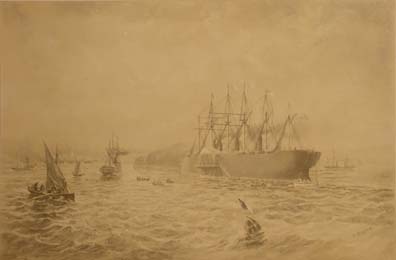
SS Great Eastern after laying cable in 1866 (Photo
B36/13) |
Until the mid-1850’s Thomson's work had been mainly in pure science –
mathematics, the flow and transformations of heat, the mathematical
theory of electric equilibrium and hydrodynamics. He soon, however,
became firmly engaged in the practical science of telegraphy.
In 1854 Latimer Clark's experiments on the retardation of signals
in the Anglo-Dutch cable and Faraday's own investigations into the
subject led him to make calculations himself, which resulted in his
showing for the first time the law governing this retardation. It was,
he calculated, proportional to the square of the length of the cable,
so that a single impulse sent through thousands of miles might take
ten seconds or more at the receiving end to achieve maximum intensity.
Thomson attacked the problem in two ways, by conducting experiments
in his laboratory on the conductivity of copper, and by designing a
receiver, the mirror galvanometer, which worked on as small a current
as possible.
|
| He became a director of the Atlantic Telegraph Co., and when the
company's electrician fell ill, he accompanied the first cable-laying
expedition in 1857. The cable unfortunately parted after 330 miles. Of
greater importance for its ultimate performance, however, was the fact
that the contracts for the supply of the cable had been entered into
by a provisional committee of the company before the appointment of
directors and before any scientific advice on the suitability of
different types of cable had been sought: Thomson had found
experimentally that even small impurities in the copper would reduce
its conductive capacity by 30 or 40 per cent.
In 1858 a cable was successfully laid, to tumultuous rejoicings on
both sides of the Atlantic. The company’s electrician, however,
insisted on using his own instrument instead of Thomson's - and burned
the cable out by the application of several thousand volts. In its 23
days of operation 732 messages were sent, including news of the end of
the Indian Mutiny.
At the fourth attempt, in 1866, the cable was successful, and Thomson's
endeavours in ensuring its ultimate success earned him both world-wide
fame and a knighthood. The Kelvin Papers are rich in correspondence
relating to the Atlantic venture and preserve some fifty of the original
signals of the first cable of 1858.
|
To read the selection of letters in full, click on the
thumbnails to view larger versions & then click on the 'back' button
to return to this page (depending upon your browser, in viewing the
larger version, you may have to click upon an additional button which
will appear at the lower right corner to see the image at its largest
size)
13 August 1858, service message to Valencia (MS
Kelvin A19)"... You must work slower as some of your dots do not
show on most delicate detector..."
|
|
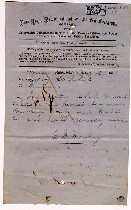
Message: page 1 |
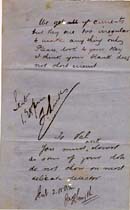
Message: page 2 |
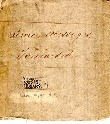
Envelope front |

Envelope back |
16 August 1858, James Buchanan, President of the United States,
to Queen Victoria (MS Kelvin A26)"…May the Atlantic telegraph
under the blessing of Heaven prove to be a bond of perpetual peace and
friendship between the kindred nations..."
|
18 August 1858, Samuel Cunard to D. & C. Mclver (MS Kelvin A30)
"... Arabia in collision with Europa Cape Race Saturday... No loss of
life or limb..."
|
4 September 1858, inhabitants of Sackville, New Brunswick, to
Sir Walter Carden, Lord Mayor of London (MS Kelvin A56)"... We
no longer feel as distant colonists but that we actually form part of
the glorious British Empire..."
|
|
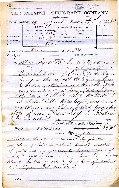
Recto |
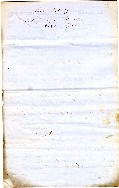
Verso |
28 September 1858, service message to Valencia (MS Kelvin A61)
"... If you receive this, notice effect of our putting one Daniels
[cell] in circuit..."
|
|